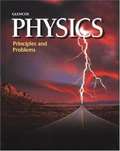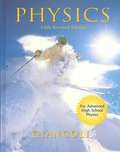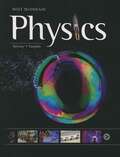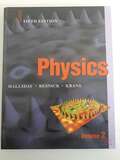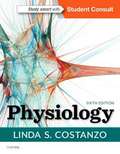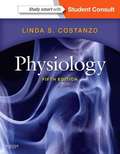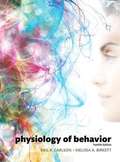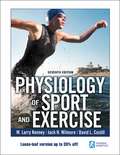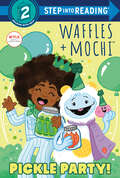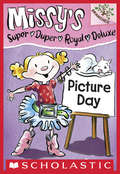- Table View
- List View
Physics: Principles and Problems (Physics:princ And Problems Ser.)
by Paul W. ZitzewitzScience textbook for high school students.
Physics: Principles with Applications
by Douglas C. Giancoli Randall D. KnightPhysics: Principles with Applications (Fourth Custom Edition for SUNY Binghamton)
Physics: Principles with Applications
by Douglas GiancoliThe ultimate aim is to give students a thorough understanding of the basic concepts of physics in all its aspects, from mechanics to modern physics. A second objective is to show students how useful physics is in their own everyday lives and in their future professions by means of interesting applications to biology, medicine, architecture, and more.
Physics: Principles with Applications (5th Revised Edition)
by Douglas C. GiancoliPhysics textbook for teens.
Physics: Principles with Applications (6th Edition, Updated)
by Douglas C. GiancoliThis book is written for students to give a thorough understanding of the basic concepts of physics in all its aspects, from mechanics to modern physics. It aims to explain physics in a readable and interesting manner that is accessible and clear, and to teach students by anticipating their needs and difficulties without oversimplifying.
Physics: Principles with Applications (6th edition)
by Douglas C. GiancoliThis algebra-based physics text contains many intriguing applications, including airbags, bungee jumping, photocopiers, highway mirages, and computer hard drives. The pedagogy has been updated to reflect new research on how students learn. Consequently, chapters now include two or three conceptual examples--each a sort of brief Socratic question and answer. Estimating examples show how to make order-of-magnitude estimates even when the data are scarce.
Physics: Principles with Applications (6th edition)
by Douglas C. GiancoliThis algebra-based physics text contains many intriguing applications, including airbags, bungee jumping, photocopiers, highway mirages, and computer hard drives. The pedagogy has been updated to reflect new research on how students learn. Consequently, chapters now include two or three conceptual examples--each a sort of brief Socratic question and answer. Estimating examples show how to make order-of-magnitude estimates even when the data are scarce.
Physics: The Foundational Science
by Sean Vinaja Ed RickardThis book makes physics understandable and provides thorough and detailed explanations with a touch of humor, which helps students grasp the most perplexing questions. Wherever possible, the principles of physics are illustrated by everyday experience and practical devices. Students are shown how the many kinds of technology from the camera to the car actually function. Numerous illustrative problems are solved in detail. <p><p>This textbook can play an important role in showing students the harmony between scientific knowledge and Christian belief. The text is firmly grounded on the view that we live in a God-created world governed by laws discoverable by reverent scientific inquiry. Interspersed throughout the text are biographies of great physicists who were also Bible-believing Christians.
Physics: Volume 2
by David Halliday Robert Resnick Kenneth S. KraneWritten for the full year or three term Calculus-based University Physics course for science and engineering majors, the publication of the first edition of Physics in 1960 launched the modern era of Physics textbooks. It was a new paradigm at the time and continues to be the dominant model for all texts. Physics is the most realistic option for schools looking to teach a more demanding course. The entirety of Volume 2 of the 5th edition has been edited to clarify conceptual development in light of recent findings of physics education research. End-of-chapter problem sets are thoroughly over-hauled, new problems are added, outdated references are deleted, and new short-answer conceptual questions are added.
Physics: the Physical Setting 2012 Prentice Hall Brief Review for the New York Regents Exam
by Bernadine Hladik CookThis book is designed to enhance review of the concepts, skills, and applications of the physical setting/physics core curriculum that may be tested on the physical setting/physics regents examination.
Physiology
by Linda S. CostanzoPhysiology, 6th Edition ideal for coursework and USMLE preparation. Well-designed figures and tables provide handy visuals for procedures or physiologic equations, and step-by-step explanations clarify challenging concepts. This full-color, manageably-sized text offers a comprehensive and consistent overview of core physiologic concepts at the organ system and cellular levels, making complex principles easy to understand.
Physiology (Fifth Edition)
by Linda S. CostanzoThis book offers a comprehensive overview of core physiologic concepts at the organ system and cellular levels.
Physiology Of Behavior
by Neil Carlson Melissa BirkettPhysiology of Behavior provides a scholarly yet accessible portrait of the dynamic interaction between biology and behavior. Lead author Neil Carlson and new co-author Melissa Birkett drew upon their experience teaching and working with students to create the new edition of this comprehensive and accessible guide for students of behavioral neuroscience. In addition to updated research, the Twelfth Edition offers an updated art and visual program and a more robust learning architecture that highlights key concepts, guiding students through the text.
Physiology of Sport and Exercise
by Jack H. Wilmore David L. Costill W. Larry KenneyThis is the loose-leaf version of Physiology of Sport and Exercise, Seventh Edition With Web Study Guide. Combining research with extensive visual aids, this resource offers a simple way for students to develop an understanding of the body's abilities to perform various types and intensities of exercise and sport, to adapt to stressful situations, and to improve its physiological capacities. This seventh edition has been updated based on the most recent position stands, standards, and guidelines in the field of sport and exercise physiology.
Pickle Party! (Step into Reading)
by Frank BerriosNetflix's Waffles + Mochi is an all-new children&’s show from President Barack and Michelle Obama&’s production company, Higher Ground Productions! Waffles and Mochi&’s friend Kennedy loves all kinds of pickled food. But when they try to get pickles for her birthday party, Waffles and Mochi learn that pickles aren&’t made quickly. Boys and girls ages 4 to 6 will love all the delicious details in this Step 2 Step into Reading leveled reader, which includes over 30 stickers. Step 2 readers use basic vocabulary and short sentences to tell simple stories. Step 2 is for children who recognize familiar words and can sound out new words with help. Join Waffles and Mochi for global adventures that reveal the stories behind our food. Produced by President Barack and Michelle Obama&’s Higher Ground Productions and streaming on Netflix, Waffles + Mochi is an entertaining mix of puppetry, animation, celebrity chefs, and famous guest stars. This delightful new show introduces young children and their families to a world of cooking and fearless eating.
Pickleball: From a Game to a Sport / What Kind of Name is Pickleball? (Fountas & Pinnell Classroom, Guided Reading Grade 4)
by Dom HowardNIMAC-sourced textbook
Picnic Lunch (Fountas & Pinnell Classroom, Guided Reading Kindergarten)
by Sarah SamuelsNIMAC-sourced textbook
Picture Cards, Grade K (Into Reading, Read Aloud Module 10)
by Houghton Mifflin Harcourt Publishing CompanyNIMAC-sourced textbook
Picture Day: A Branches Book (Missy's Super Duper Royal Deluxe #1)
by Susan Nees<P>This series (just like Missy herself) is super duper royal deluxe! <P>This series is part of Scholastic's early chapter book line, Branches. Aimed at 5- to 7-year-olds, this line of books is for children who are just starting to read independently. With easy-to-read text, high-interest content, fast-paced plots, and illustrations on every page, these books will boost reading confidence and stamina. Branches books help readers grow! <P>Missy is a very creative girl who does everything in her own super duper royal deluxe way! This first book is about Missy's school picture day. Despite Missy's keen fashion sense, her mother insists on choosing her picture-day outfit for her. But Missy thinks it's the most boring outfit EVER! She simply must find a way to make her picture-day outfit her own. With her trusty friend Oscar and her cat named Pink by her side, Missy is sure to come up with an outfit that's truly super duper royal deluxe! Full-color illustrations throughout.
